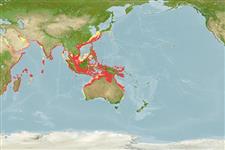Preferred temperature (Αναφ.
123201): 22.1 - 28.3, mean 26.8 °C (based on 839 cells).
Phylogenetic diversity index (Αναφ.
82804): PD
50 = 0.6250 [Uniqueness, from 0.5 = low to 2.0 = high].
Bayesian length-weight: a=0.00759 (0.00654 - 0.00880), b=3.07 (3.03 - 3.11), in cm total length, based on LWR estimates for this species (Ref.
93245).
Τροφικό Επίπεδο (Αναφ.
69278): 3.5 ±0.2 se; based on diet studies.
Generation time: 17.2 ( na - na) years. Estimated as median ln(3)/K based on 2
growth studies.
Ελαστικότητα (Αναφ.
120179): Χαμηλό, ελάχιστος χρόνος για διπλασιασμό πληθυσμού 4,5 - 14 έτη (K=0.06-0.45; tm=2-4; tmax=19; Fec=34-88).
Prior r = 0.31, 95% CL = 0.20 - 0.46, Based on 4 data-limited stock assessments.
Fishing Vulnerability (Ref.
59153): Moderate to high vulnerability (48 of 100).
🛈
Climate Vulnerability (Ref.
125649): High vulnerability (57 of 100).
🛈
Nutrients (Ref.
124155): Calcium = 26.3 [14.3, 64.9] mg/100g; Iron = 0.78 [0.47, 1.40] mg/100g; Protein = 18.1 [16.3, 19.9] %; Omega3 = 0.348 [0.179, 0.692] g/100g; Selenium = 46.2 [23.4, 97.4] μg/100g; VitaminA = 6.46 [2.31, 18.39] μg/100g; Zinc = 0.682 [0.451, 1.055] mg/100g (wet weight);
